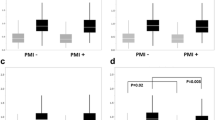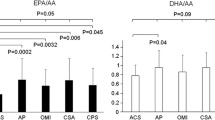Abstract
Residual risk of cardiovascular events after treatment with stain might be explained in part because patients have low levels of n−3 polyunsaturated fatty acids (PUFA). We examined how lipid-lowering therapy with strong statin affected serum PUFA levels in patients with coronary artery disease. The study population consisted of 46 patients with coronary artery disease whose low-density lipoprotein (LDL) cholesterol was more than 100 mg/dl. Lipid-lowering therapy was performed with a strong statin including atorvastatin (n = 22), rosuvastatin (n = 9) or pitavastatin (n = 15). Serum PUFA levels were determined by gas chromatography. The treatment with strong statin decreased the sum of dihomo-γ-linolenic acid (DGLA) and arachidonic acid (AA) levels (195 ± 41 to 184 ± 44 μg/ml, P < 0.05) as well as the sum of eicosapentaenoic acid (EPA) and docosahexaenoic acid (DHA) levels (233 ± 71 to 200 ± 72 μg/ml, P < 0.001). These effects of strong statin resulted in a significant decrease in ratio of the sum of EPA and DHA levels to the sum of DGLA and AA levels (1.20 ± 0.27 to 1.10 ± 0.35, P < 0.05). The percent decrease in the LDL cholesterol level correlated significantly with that in the sum of EPA and DHA levels (r = 0.38, P < 0.01). In conclusion, our results showed that lipid-lowering therapy with strong statin mainly reduced n−3 PUFAs in proportion to the decrease in the LDL cholesterol level in patients with coronary artery disease.


Similar content being viewed by others
References
Scandinavian Simvastatin Survival Study Group (1994) Randomized trial of cholesterol lowering in 4444 patients with coronary heart disease: the Scandinavian Simvastatin Survival Study (4S). Lancet 344:1383–1389
Sacks FM, Pfeffer MA, Moye LA, Rouleau JL, Rutherford JD, Cole TG, Brown L, Warnica JW, Arnold JM, Wun CC, Davis BR, Braunwald E (1996) The effect of pravastatin on coronary events after myocardial infarction in patients with average cholesterol levels. N Engl J Med 335:1001–1009
The Long-Term Intervention with Pravastatin in Ischaemic Disease (LIPID) Study Group (1998) Prevention of cardiovascular events and death with pravastatin in patients with coronary heart disease and a broad range of initial cholesterol levels. N Engl J Med 339:1349–1357
Fujita M, Yamazaki T, Hayashi D, Kohro T, Okada Y, Nagai R, JCAD Study Investigators et al (2008) Pleiotropic effects of statins on cardiovascular events in the Japanese Coronary Artery Disease study. Int J Cardiol 129:294–296
Tavridou A, Efthimiadis A, Efthimiadis I, Manolopoulos VG (2010) Simvastatin-induced changes in circulating oxidized low-density lipoprotein in different types of dyslipidemia. Heart Vessels 25:288–293
Ridker PM, Genest J, Boekholdt SM, Libby P, Gotto AM, Nordestgaard BG, Mora S, MacFadyen JG, Glynn RJ, Kastelein JJ, JUPITER Trial Study Group et al (2010) HDL cholesterol and residual risk of first cardiovascular events after treatment with potent statin therapy: an analysis from the JUPITER trial. Lancet 376:333–339
Rupp H, Wagner D, Rupp T, Schulte L-M, Maisch B (2004) Risk stratification by the “EPA + DHA level” and the “EPA/AA ratio”: focus on anti-inflammatory and antiarrhythmogenic effects of long-chain omega-3 fatty acids. Herz 29:673–685
Harris WS, Poston WC, Haddock CK (2007) Tissue n-3 and n-6 fatty acids and risk for coronary heart disease events. Atherosclerosis 193:1–10
Daviglus ML, Stamler J, Orencia AJ, Dyer AR, Liu K, Greenland P, Walsh MK, Morris D, Shekelle RB (1997) Fish consumption and the 30-year risk of fatal myocardial infarction. N Engl J Med 336:1046–1053
Albert CM, Campos H, Stampfer MJ, Ridker PM, Manson JE, Willett WC, Ma J (2002) Blood levels of long-chain n-3 fatty acids and the risk of sudden death. N Engl J Med 346:1113–1118
Hu FB, Bronner L, Willett WC, Stampfer MJ, Rexrode KM, Albert CM, Hunter D, Manson JE (2002) Fish and omega-3 fatty acid intake and risk of coronary heart disease in women. JAMA 287:1815–1821
Ueeda M, Doumei T, Takaya Y, Ohnishi N, Takaishi A, Hirohata S, Miyoshi T, shinohata R, Usui S, Kusachi S et al (2011) Association of serum levels of arachidonic acid and eicosapentaenoic acid with prevalence of major adverse cardiac events after acute myocardial infarction. Heart Vessels 26:145–152
Rupp H, Rupp TP, Alter P, Maisch B (2010) Inverse shift in serum polyunsaturated and monounsaturated fatty acids is associated with adverse dilatation of the heart. Heart 96:595–598
Yli-Jama P, Meyer HF, Ringstad J, Pedersen JI (2002) Serum fatty acid pattern and risk of myocardial infarction: a case–control study. J Intern Med 251:19–28
Kaluzny MA, Duncan LA, Merritt MV, Epps DE (1985) Rapid separation of lipid classes in high yield and purity using bonded phase columns. J Lipid Res 26:135–140
Folch J, Lees M, Sloane M, Stanley G (1957) A simple method for the isolation and purification of total lipids from animal tissues. J Biol Chem 226:497–509
Hoshi M, Williams M, Kishimoto Y (1973) Esterification of fatty acids at room temperature by chloroform-methanolic HCL-cupric acetate. J Lipid Res 14:599–601
Shishehbor MH, Zhang R, Medina H, Brennan ML, Brennan DM, Ellis SG, Topol EJ, Hazen SL (2006) Systemic elevations of free radial oxidation products of arachidonic acid are associated with angiographic evidence of coronary artery disease. Free Radic Biol Med 41:1678–1683
Tretjakovs P, Kalnins U, Dabina I, Erglis A, Dinne I, Jurka A, Latkovskis G, Zvaiqzne A, Piraqs V (2003) Nitric oxide production and arachidonic acid metabolism in platelet membranes of coronary heart disease patients with and without diabetes. Med Princ Pract 12:10–16
Dwyer JH, Allayee H, Dwyer KM, Fan J, Wu H, Mar R, Lusis AJ, Mehrabian M et al (2004) Arachidonate 5-lipoxygenase promoter genotype, dietary arachidonic acid and atherosclerosis. N Engl J Med 350:29–37
Terano T, Salmon JA, Moncada S (1984) Effect of orally administered eicosapentaenoic acid (EPA) on the formation of leukotriene B4 and leukotriene B5 by rat leukocytes. Biochem Pharmacol 33:3071–3076
Wallace JM, Turley E, Gilmore WS, Strain JJ (1995) Dietary fish oil supplementation alters leukocyte function and cytokine production in healthy women. Arterioscler Thromb Vasc Biol 15:185–189
Gruppo Italiano per lo Studio della Sopravvivenza nell’infarto miocardico (1999) Dietary supplementation with n-3 polyunsaturated fatty acids and vitamin E after myocardial infarction: results of the GISSI-Prevenzione trial. Lancet 354:447–455
Matsuzaki M, Yokoyama M, Saito Y, Origasa H, Ishikawa Y, Oikawa S, Sasaki J, Hishida H, Itakura H, Kita T, Kitabatake A, Nakaya N, Sakata T, Shimada K, Shirato K, Matsuzawa Y, JELIS Investigators (2009) Incremental effects of eicosapentaenoic acid on cardiovascular events in statin-treated patients with coronary artery disease: secondary prevention analysis from JELIS. Circ J 73:1283–1290
Nakamura N, Hamazaki T, Ohta M, Okuda K, Urakaze M, Sawazaki S, Yamazaki K, Satoh A, Temaru R, Ishikura Y, Takata M, Kishida M, Kobayashi M (1999) Joint effects of HMG-CoA reductase inhibitors and eicosapentaenoic acids on serum lipid profile and plasma fatty acid concentrations in patients with hyperlipidemia. Int J Clin Lab Res 29:22–25
Jula A, Marniemi J, Ronnemaa T, Virtanen A, Huupponen R (2005) Effects of diet and simvastatin on fatty acid composition in hypercholesterolemic men. Arterioscler Thromb Vasc Biol 25:1952–1959
Das UN (2011) Beneficial actions of statins in the reduction of atrial fibrillation and stabilization and regression of coronary plaques: but how and why? Circ J 75:224–225
Garg ML, Snoswell AM, Sabine JR (1986) Influence of dietary cholesterol on desaturase enzymes of rat liver microsomes. Prog Lipid Res 25:639–644
Leikin AI, Brenner RR (1988) In vivo cholesterol removal from liver microsomes induces changes in fatty acid desaturase activities. Biochim Biophys Acta 963:311–319
Author information
Authors and Affiliations
Corresponding author
Rights and permissions
About this article
Cite this article
Kurisu, S., Ishibashi, K., Kato, Y. et al. Effects of lipid-lowering therapy with strong statin on serum polyunsaturated fatty acid levels in patients with coronary artery disease. Heart Vessels 28, 34–38 (2013). https://doi.org/10.1007/s00380-011-0213-6
Received:
Accepted:
Published:
Issue Date:
DOI: https://doi.org/10.1007/s00380-011-0213-6




